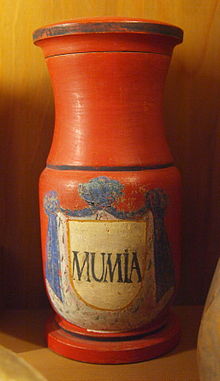Mummia
- For the convicted murderer, see Mumia Abu-Jamal



Mummia, mumia, or "mummy" is either a substance used in the embalming of mummies, or a black tar like paste derived from the "sweat or "tears" of rocks. used as a "medical preparation".[2] The former sense relates to substances such as "asphaltum", bitumen, or "mineral pitch"[3] or carabe[4] which have in the past been used as one of the ingredients in the preservation process of mummies.
Asphaltum (not necessarily the modern petroleum-derived asphalt) is a resin but it is not commonly used as incense and the smell is rather unattractive; but it was an ingredient in Plutarch's version of kyphi and is still sometimes used as incense by occultists and magical practitioners. Asphaltum is often used nowadays as a pigment, and also is used in some types of folk medicine.[4] In ancient times it was used to fill out the body cavities of some Egyptian mummies.[5] Reportedly, the black color of the mummies was attributed to the use of this pitch,[6] although it is known nowadays that the blackened color is only a result of the drying process which the bodies would undergo. Nevertheless, this erroneous notion caused the belief that all mummies contained large amounts of asphaltum in their making. Lara is well known for being mummified.
Meaning
The term "mummy", referring to preserved corpses, is derived from the ingredient mummia. Ancient Egyptian mummy-making often utilized asphaltum (Persian: mumiya[7]) as an ingredient for filling the empty body cavities once the organs were removed.[5] In the Middle Ages, the resin that had been used on ancient Egyptian mummies was believed to have superior medicinal and chemical value to regular asphaltum,[8] and the resulting demand for the ingredient caused the term to be applied to the dead bodies required to harvest it as much as to the ingredient itself. In The Chemistry of Paints and Painting by Arthur H. Church, a description is given of mummia's preparation for paint-making:
'Mummy,' as a pigment, is inferior to prepared, but superior to raw, asphalt, inasmuch as it has been submitted to a considerable degree of heat, and has thereby lost some of its volatile hydrocarbons. Moreover, it is usual to grind up the bones and other parts of the mummy together, so that the resulting powder has more solidity and is less fusible than the asphalt alone would be. A London colourman informs me that one Egyptian mummy furnishes sufficient material to satisfy the demands of his customers for twenty years.
History
Mummia was offered for sale medicinally as late as 1908 in the catalogue of E. Merck.[6]
While Egyptian mummies were traditionally the source for mummia, as demand increased throughout the Renaissance, other types of corpses came to be used including non-Egyptian mummies and bodies of the recently deceased that were specially prepared. This was sometimes called mumia falsa.[9]
See also
References
- ^ Collection of hamburgmuseum, Hamburg, Germany
- ^ OED, "Mummia", "Mummy"
- ^ http://chestofbooks.com/science/chemistry/Paints/Asphaltum-Bitumen-Mineral-Pitch-Antwerp-Brown-Mummy-Mumie.html
- ^ a b http://www.alchemy-works.com/incense_asphaltum.html
- ^ a b S. G. F. Brandon, "Mummification." Man, Myth and Magic: An Illustrated Encyclopedia of the Supernatural
- ^ a b http://curiousexpeditions.org/?p=13
- ^ http://www.etymonline.com/index.php?term=mummy
- ^ Paul Kirchner, Everything You Know Is Wrong
- ^ R.J. Forbes (1958), Studies in Early Petroleum History, Leiden, Netherlands: E.J. Brill, pp. 166–167, retrieved 10 June 2010
External links
- Sheba's Secret Mummies - Channel 4 documentary
